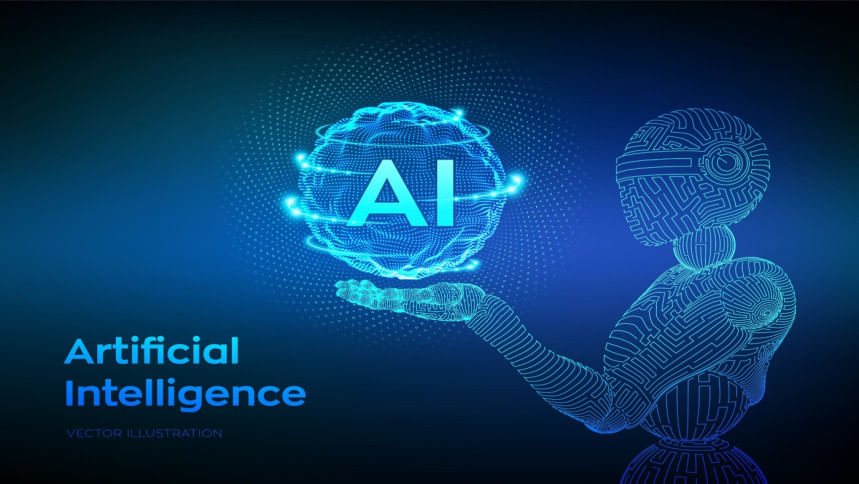Bangladesh’s low AI readiness puts young workforce at risk: WB

- World Bank warns Bangladesh lags in AI
- Young workforce faces disruption without reforms
- Digital gaps, weak skills hinder adoption
- AI offers growth chance if harnesse
Artificial intelligence (AI) is poised to reshape Bangladesh's economy, yet the country's preparedness remains low, leaving its vast young workforce vulnerable to disruption, according to the World Bank's latest South Asia Development Update (October 2025).
The report, launched yesterday at the bank's Dhaka office, describes AI as "a transformative general-purpose technology" that could accelerate productivity and economic growth, provided that the right digital and human capital foundations are built.
"Increasing trade openness and the growing adoption of AI could be transformative for South Asia," said Franziska Ohnsorge, the World Bank's chief economist for South Asia.
"Policy measures to facilitate the reallocation of workers across firms, activities, and locations can help channel resources to productive sectors and are critical for boosting investment and job creation in the region," she added.
The report states that Bangladesh sits at the lower end of AI readiness in South Asia, with the region's average occupational exposure to AI "among the lowest globally."
WB describes AI as "a transformative general-purpose technology" that could accelerate productivity and economic growth
Bangladesh's exposure, it adds, is "well below the regional average," reflecting its dependence on agriculture, garment manufacturing, and informal services — sectors least affected by automation so far. That low exposure could soon become a liability.
"As AI technologies diffuse through global services and manufacturing value chains, Bangladesh's low exposure today could quickly become a disadvantage tomorrow," the report warns.
Drawing on evidence from advanced economies, the bank noted that automation through industrial robots and digital systems has already depressed employment and wages elsewhere. While Bangladesh's immediate exposure is limited, "the potential for adverse labour market consequences from AI adoption is particularly acute in South Asia's young, fast-growing labour markets."
Young and moderately educated workers are seen as most at risk, especially in entry-level white-collar roles such as customer service, data entry, and software support — fields increasingly vital to Bangladesh's growing service exports.
AI adoption, the report stresses, depends critically on digital infrastructure and human capital — two areas where Bangladesh continues to lag.
Only around 62 percent of the population has internet access, and reliable high-speed broadband remains largely confined to urban areas. The 32-percentage-point rural-urban gap in internet access is the largest among all emerging-market regions, the WB observed.
Education systems have also failed to keep pace with the demands of digital transformation. "Only 75 percent of South Asians are literate, compared with 85 percent in other emerging markets," the report noted — a gap particularly visible in Bangladesh.
It further pointed out that "a large number of highly educated South Asian AI researchers have emigrated abroad," echoing concerns about Bangladesh's own technology talent drain.
Despite these weaknesses, the report highlights a window of opportunity. If Bangladesh can invest in digital skills and infrastructure, AI could substantially boost productivity and income growth.
"AI could boost productivity significantly in South Asia if the preconditions are in place," the bank said. For Bangladesh, that means improving broadband access, ensuring reliable electricity, and expanding programmes to teach both digital literacy and AI-related skills.
The country's young demographic could also be an advantage. "It may be easier for South Asia to adopt AI given its relatively young and growing labour force," the report argued, "provided workers have access to opportunities for building AI-related skills."
AI's potential applications are wide-ranging: improving logistics efficiency, expanding financial inclusion through digital credit scoring, and boosting agricultural productivity via predictive analytics. Early experiments in AI-assisted education and healthcare diagnostics could, the report said, help "expand access to quality learning and healthcare."
Yet the WB cautions that without strong institutions and coordinated reforms, these opportunities could remain out of reach. "Artificial intelligence offers Bangladesh the chance to leapfrog into higher productivity — but without strong institutions and coordinated reforms, the technology will remain underused."
SOUTH ASIA'S AI DIVIDE
Across South Asia, AI adoption is highly uneven. "Levels of AI penetration and engagement are relatively low in emerging markets and developing economies," the report said, "but engagement is rising sharply."
India leads the region's AI transformation, with jobs requiring AI skills commanding a wage premium of nearly 30 percent, the WB found. Smaller economies, including Bangladesh, Nepal, and Bhutan, have yet to experience significant AI-driven employment growth.
While South Asia's average occupational exposure to AI remains below the global developing-country average, the region does have one advantage: around 70 percent of AI-exposed jobs are complementary, meaning humans and machines can work together. That is the highest share among all developing regions.
"AI does not have to mean job losses," the report emphasised. "Where human-AI complementarity is high, such as in teaching, law, and medical professions, productivity gains can offset displacement."
The message for Bangladesh and its neighbours is clear: harness AI or risk being left behind. The World Bank urged governments to build an enabling environment that combines reliable infrastructure, human-capital investment, and robust data-governance frameworks.
"Government policies can promote AI adoption with reliable and affordable access to energy and the internet," the report said.
It also recommended that public institutions themselves use AI to streamline processes, predict service demand, and automate routine tasks, ranging from chatbots to data analytics, to improve transparency and service delivery.

 For all latest news, follow The Daily Star's Google News channel.
For all latest news, follow The Daily Star's Google News channel. 



Comments